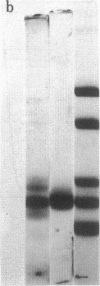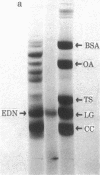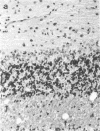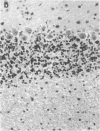Abstract
Human and animal eosinophils contain a powerful neurotoxin that causes selective neuronal and axonal damage to white matter of cerebellum and spinal cord of experimental animals when injected intrathecally. This reaction is termed the "Gordon phenomenon." We purified the eosinophil-derived neurotoxin from eosinophil-rich leukocyte suspensions or eosinophil granules from four patients with various hypereosinophilic syndromes. A single protein with an average molecular weight of 18,400 was isolated by sequential chromatography on Sephadex G-50 columns and analyzed by sodium dodecyl sulfate/polyacrylamide gel electrophoresis of column fractions. The purified eosinophil-derived neurotoxin from the cells of these patients retained the potent neurotoxic activity of the crude eosinophil or eosinophil granule extracts in experimental animals. These animals developed the syndrome of stiffness and ataxia progressing to severe paralysis characteristic of the Gordon phenomenon. Histologic examination of the brains of animals injected with purified eosinophil-derived neurotoxin confirmed the characteristic widespread loss of Purkinje cells and severe spongiform vacuolation in the white matter of cerebellum, brain stem, and spinal cord. We have established the location of eosinophil-derived neurotoxin in the eosinophil granule and have shown that it is distinct from several other eosinophil proteins, the granule major basic protein, and the Charcot-Leyden crystal protein (lysophospholipase).
Full text
PDF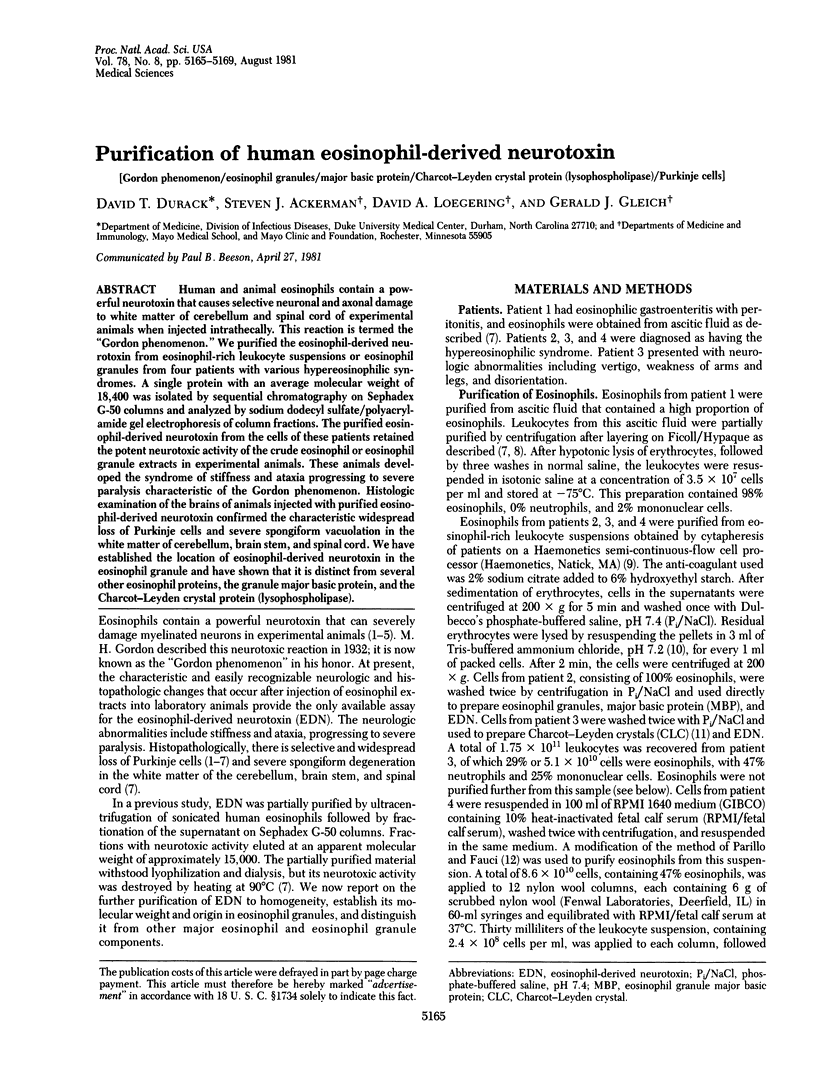
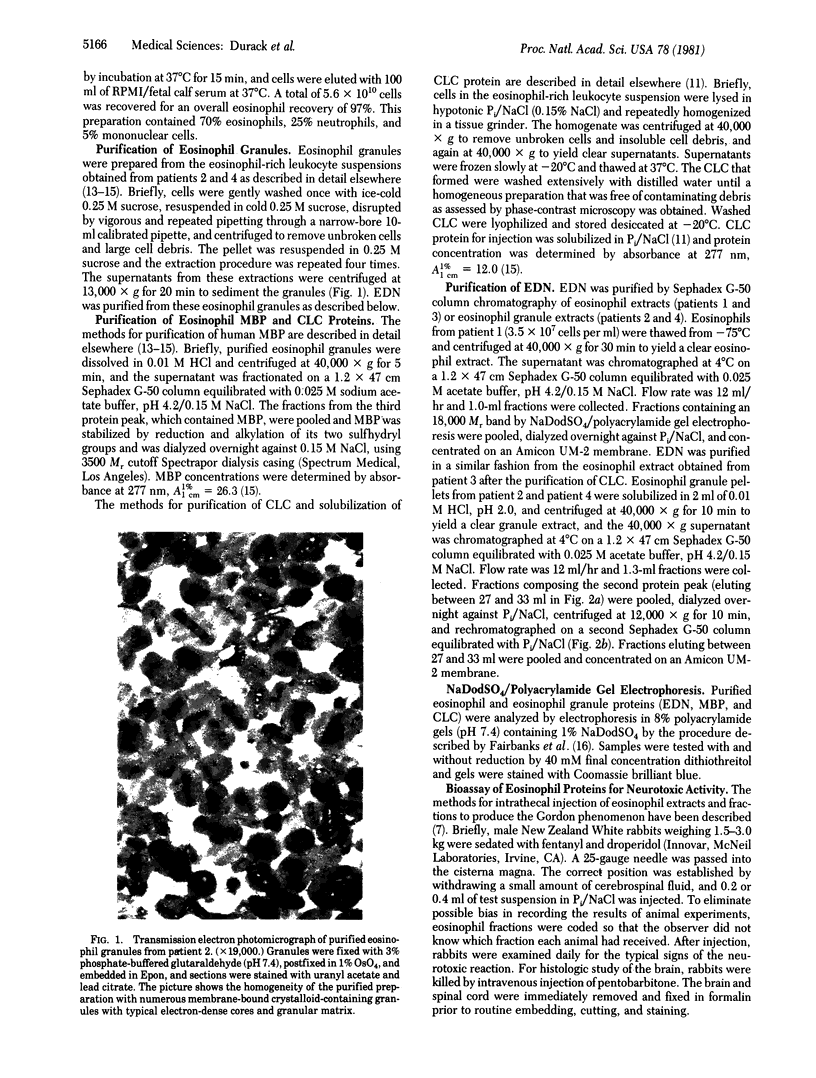
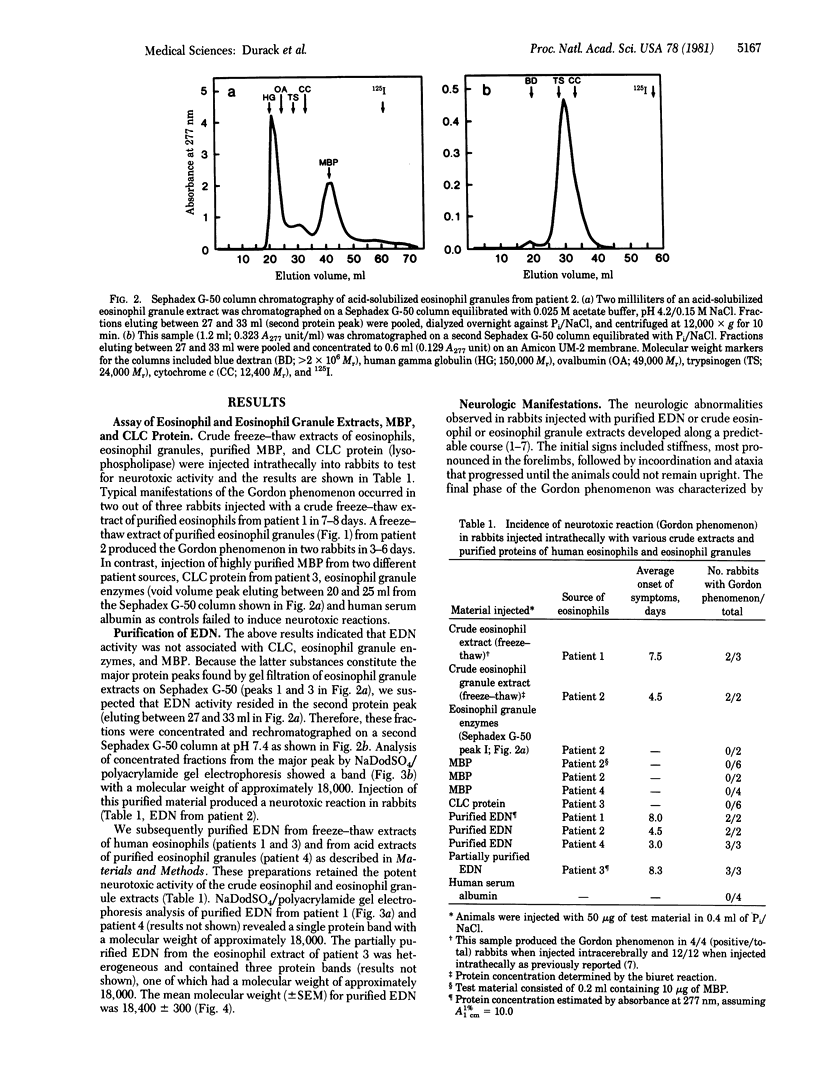
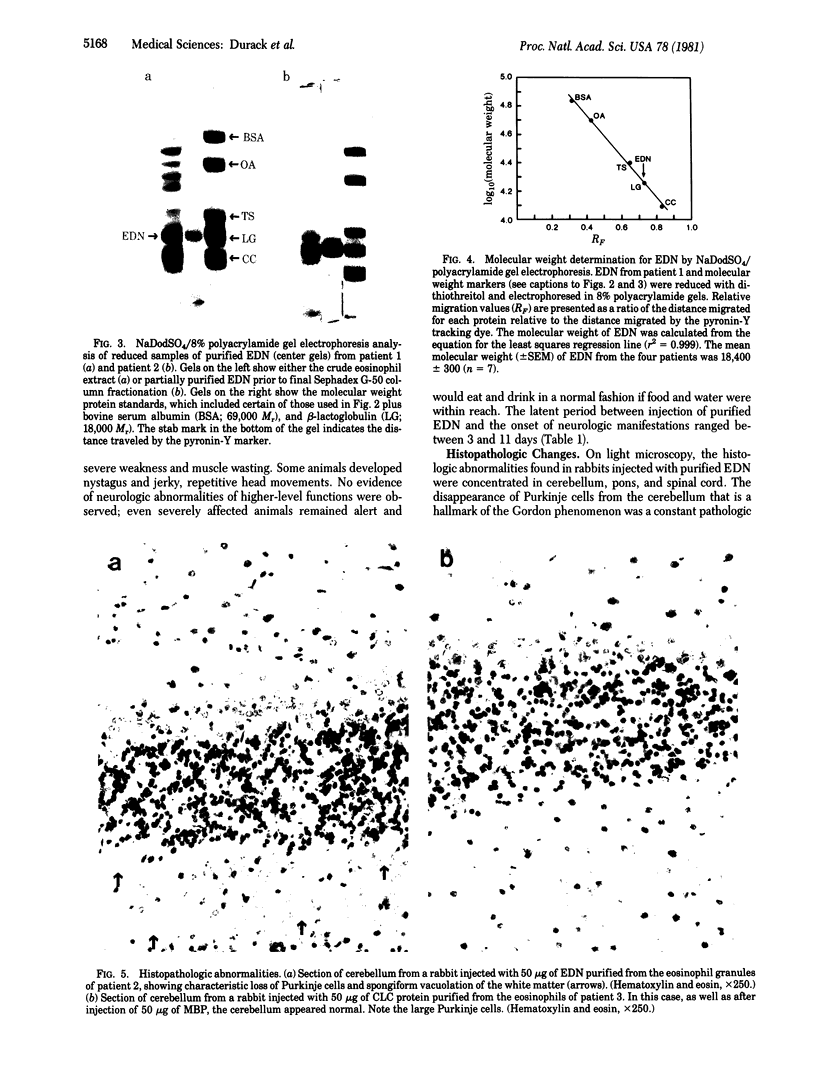
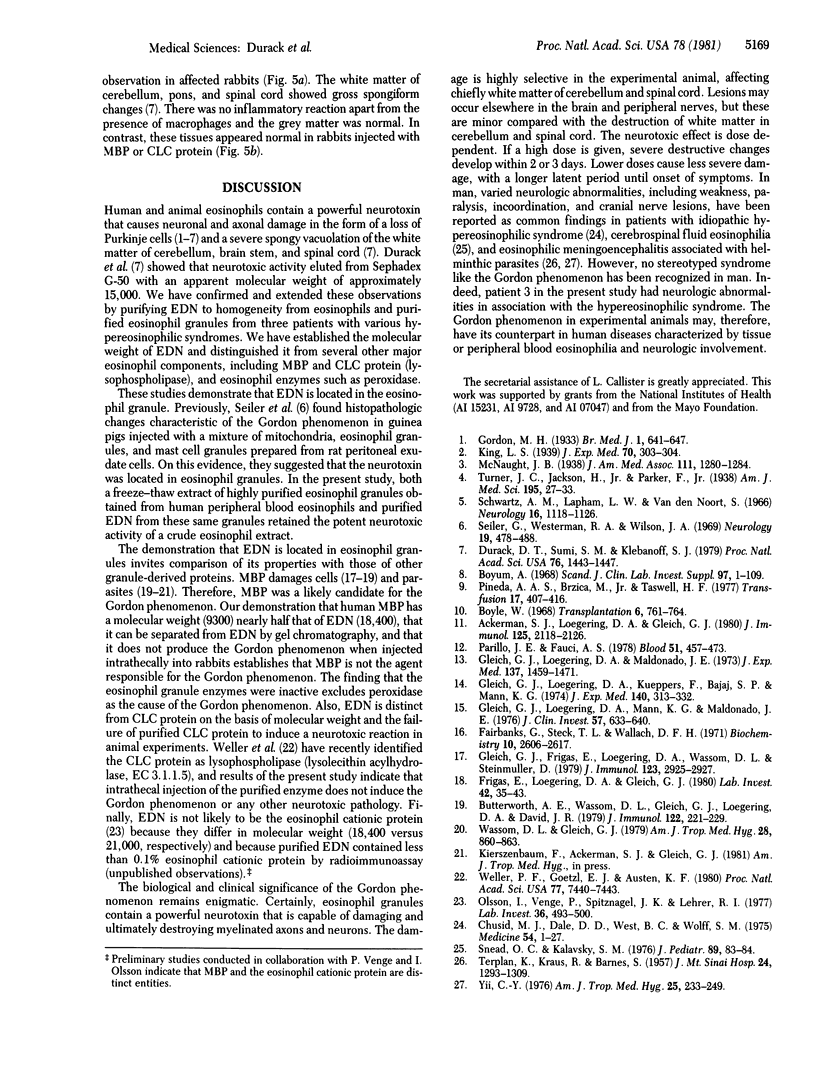
Images in this article
Selected References
These references are in PubMed. This may not be the complete list of references from this article.
- Ackerman S. J., Loegering D. A., Gleich G. J. The human eosinophil Charcot-Leyden crystal protein: biochemical characteristics and measurement by radioimmunoassay. J Immunol. 1980 Nov;125(5):2118–2126. [PubMed] [Google Scholar]
- Boyle W. An extension of the 51Cr-release assay for the estimation of mouse cytotoxins. Transplantation. 1968 Sep;6(6):761–764. doi: 10.1097/00007890-196809000-00002. [DOI] [PubMed] [Google Scholar]
- Butterworth A. E., Wassom D. L., Gleich G. J., Loegering D. A., David J. R. Damage to schistosomula of Schistosoma mansoni induced directly by eosinophil major basic protein. J Immunol. 1979 Jan;122(1):221–229. [PubMed] [Google Scholar]
- Chusid M. J., Dale D. C., West B. C., Wolff S. M. The hypereosinophilic syndrome: analysis of fourteen cases with review of the literature. Medicine (Baltimore) 1975 Jan;54(1):1–27. [PubMed] [Google Scholar]
- Durack D. T., Sumi S. M., Klebanoff S. J. Neurotoxicity of human eosinophils. Proc Natl Acad Sci U S A. 1979 Mar;76(3):1443–1447. doi: 10.1073/pnas.76.3.1443. [DOI] [PMC free article] [PubMed] [Google Scholar]
- Fairbanks G., Steck T. L., Wallach D. F. Electrophoretic analysis of the major polypeptides of the human erythrocyte membrane. Biochemistry. 1971 Jun 22;10(13):2606–2617. doi: 10.1021/bi00789a030. [DOI] [PubMed] [Google Scholar]
- Frigas E., Loegering D. A., Gleich G. J. Cytotoxic effects of the guinea pig eosinophil major basic protein on tracheal epithelium. Lab Invest. 1980 Jan;42(1):35–43. [PubMed] [Google Scholar]
- Gleich G. J., Frigas E., Loegering D. A., Wassom D. L., Steinmuller D. Cytotoxic properties of the eosinophil major basic protein. J Immunol. 1979 Dec;123(6):2925–2927. [PubMed] [Google Scholar]
- Gleich G. J., Loegering D. A., Kueppers F., Bajaj S. P., Mann K. G. Physiochemical and biological properties of the major basic protein from guinea pig eosinophil granules. J Exp Med. 1974 Aug 1;140(2):313–332. doi: 10.1084/jem.140.2.313. [DOI] [PMC free article] [PubMed] [Google Scholar]
- Gleich G. J., Loegering D. A., Maldonado J. E. Identification of a major basic protein in guinea pig eosinophil granules. J Exp Med. 1973 Jun 1;137(6):1459–1471. doi: 10.1084/jem.137.6.1459. [DOI] [PMC free article] [PubMed] [Google Scholar]
- Gleich G. J., Loegering D. A., Mann K. G., Maldonado J. E. Comparative properties of the Charcot-Leyden crystal protein and the major basic protein from human eosinophils. J Clin Invest. 1976 Mar;57(3):633–640. doi: 10.1172/JCI108319. [DOI] [PMC free article] [PubMed] [Google Scholar]
- Olsson I., Venge P., Spitznagel J. K., Lehrer R. I. Arginine-rich cationic proteins of human eosinophil granules: comparison of the constituents of eosinophilic and neutrophilic leukocytes. Lab Invest. 1977 May;36(5):493–500. [PubMed] [Google Scholar]
- Parrillo J. E., Fauci A. S. Human eosinophils. Purification and cytotoxic capability of eosinophils from patients with the hypereosinophilic syndrome. Blood. 1978 Mar;51(3):457–473. [PubMed] [Google Scholar]
- Pineda A. A., Brzica S. M., Jr, Taswell H. F. Continuous- and semicontinuous-flow blood centrifugation systems: therapeutic applications, with plasma-, platelet, lympha-, and eosinapheresis. Transfusion. 1977 Sep-Oct;17(5):407–416. doi: 10.1046/j.1537-2995.1977.17578014576.x. [DOI] [PubMed] [Google Scholar]
- Schwartz A. M., Lapham L. W., van den Noort S. Cytologic and cytochemical studies of neuroglia. IV. Experimentally induced protoplasmic astrocytosis in the Bergmann glia of cerebellum. Neurology. 1966 Nov;16(11):1118–1126. doi: 10.1212/wnl.16.11.1118. [DOI] [PubMed] [Google Scholar]
- Seiler G., Westerman R. A., Wilson J. A. The role of specific eosinophil granules in eosinophil-induced experimental encephalitis. Neurology. 1969 May;19(5):478–488. doi: 10.1212/wnl.19.5.478. [DOI] [PubMed] [Google Scholar]
- Snead O. C., 3rd, Kalavsky S. M. Cerebrospinal fluid eosinophilia. A manifestation of a disorder resembling multiple sclerosis in childhood. J Pediatr. 1976 Jul;89(1):83–84. doi: 10.1016/s0022-3476(76)80935-3. [DOI] [PubMed] [Google Scholar]
- TERPLAN K., KRAUS R., BARNES S. Eosinophilic meningo-encephalitis, with predominantly cerebellar changes caused by Trichinella infection. J Mt Sinai Hosp N Y. 1957 Nov-Dec;24(6):1293–1309. [PubMed] [Google Scholar]
- Wassom D. L., Gleich G. J. Damage to Trichinella spiralis newborn larvae by eosinophil major basic protein. Am J Trop Med Hyg. 1979 Sep;28(5):860–863. [PubMed] [Google Scholar]
- Weller P. F., Goetzl E. J., Austen K. F. Identification of human eosinophil lysophospholipase as the constituent of Charcot-Leyden crystals. Proc Natl Acad Sci U S A. 1980 Dec;77(12):7440–7443. doi: 10.1073/pnas.77.12.7440. [DOI] [PMC free article] [PubMed] [Google Scholar]
- Yii C. Y. Clinical observations on eosinophilic meningitis and meningoencephalitis caused by Angiostrongylus cantonensis on Taiwan. Am J Trop Med Hyg. 1976 Mar;25(2):233–249. doi: 10.4269/ajtmh.1976.25.233. [DOI] [PubMed] [Google Scholar]




